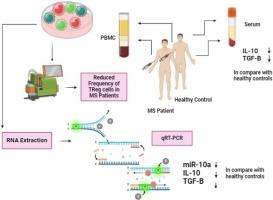多发性硬化症患者外周血单核细胞中 miR-10a 基因表达的改变与 T 调节细胞的频率和细胞因子谱相关。
IF 2.5
4区 医学
Q3 NEUROSCIENCES
引用次数: 0
摘要
诱发自身免疫性多发性硬化症(MS)并使其发展的一个关键因素是免疫反应失调,包括 T 调节细胞(Tregs)功能失调,而 Tregs 是炎症发病过程中的关键参与者。研究发现,miRNA 在多发性硬化症的诱导过程中起着至关重要的作用,因为 miRNA 的失调会导致免疫耐受的缺陷。在这项研究中,我们通过比较 40 名多发性硬化症患者和 40 名健康对照者的外周血单核细胞(PBMC)中 miR-10a 表达的变化,研究了 miR-10a 对多发性硬化症的影响。此外,我们还研究了多发性硬化症患者与健康对照组的 Tregs 频率。我们评估了多发性硬化症患者血清中 IL-10 和 TGF-B 等抗炎细胞因子的分泌水平及其在健康对照组和患者外周血单核细胞(PBMCs)中的表达水平。然后,我们评估了 miR-10a 表达与 Treg 频率和血清中抗炎细胞因子水平之间的相关性。多发性硬化症患者的 PBMCs 中 miR-10a 的表达下调,而且发现这种表达与 Treg 细胞频率的降低以及与 Treg 功能减弱相关的抗炎细胞因子的分泌之间存在很大的相关性。总之,我们的研究表明,Tregs 的频率、与 Treg 功能相关的细胞因子水平的降低以及 PBMCs 中 miR-10a 表达的降低之间存在很强的相关性。因此,miR-10a 的改变可作为预防和治疗多发性硬化症的可能治疗靶点。然而,在将这一策略应用于临床之前,还需要进一步的研究。本文章由计算机程序翻译,如有差异,请以英文原文为准。

Altered miR-10a gene expression in peripheral blood mononuclear cells correlates with frequency of T regulatory cells and cytokine profile in multiple sclerosis patients
A critical component in triggering and progressing autoimmune multiple sclerosis (MS) is the deregulation of immune responses, including dysfunction of T regulatory cells (Tregs), critical participants in the pathogenetic context of inflammation. It has been found that miRNAs have a crucial role in the induction of MS because dysregulation of miRNAs can result in defects in immunological tolerance. In this investigation, we examined the miR-10a contribution to MS disorder by comparing the altered expression of miR-10a in peripheral blood mononuclear cells (PBMCs) of 40 MS patients to 40 healthy controls. Additionally, we examined Tregs’ frequency in MS patients in compare with healthy controls. We evaluated the secreted levels of anti-inflammatory cytokines, such as IL-10 and TGF-B, in the serum of MS patients and their expression level in healthy controls’ and patients’ peripheral blood mononuclear cells (PBMCs). Then, we assessed the correlation between miR-10a expression with Treg frequency and levels of anti-inflammatory cytokines in serum. PBMCs from MS patients had downregulated expression of miR-10a, and a substantial correlation was found between this expression and a reduction in Treg cells’ frequency and the secreted anti-inflammatory cytokines associated with Tregs’ diminished functionality. In summary, our research demonstrated a strong correlation between Tregs’ frequency, lower levels of cytokines linked to Treg function, and lower expression of miR-10a in PBMCs. So, the alteration of miR-10a can be utilized as a probable therapeutic target for the prevention and management of MS disorder. However, further examination is requisite before this strategy become practical for use in the clinical setting.
求助全文
通过发布文献求助,成功后即可免费获取论文全文。
去求助
来源期刊

Neuroscience Letters
医学-神经科学
CiteScore
5.20
自引率
0.00%
发文量
408
审稿时长
50 days
期刊介绍:
Neuroscience Letters is devoted to the rapid publication of short, high-quality papers of interest to the broad community of neuroscientists. Only papers which will make a significant addition to the literature in the field will be published. Papers in all areas of neuroscience - molecular, cellular, developmental, systems, behavioral and cognitive, as well as computational - will be considered for publication. Submission of laboratory investigations that shed light on disease mechanisms is encouraged. Special Issues, edited by Guest Editors to cover new and rapidly-moving areas, will include invited mini-reviews. Occasional mini-reviews in especially timely areas will be considered for publication, without invitation, outside of Special Issues; these un-solicited mini-reviews can be submitted without invitation but must be of very high quality. Clinical studies will also be published if they provide new information about organization or actions of the nervous system, or provide new insights into the neurobiology of disease. NSL does not publish case reports.
 求助内容:
求助内容: 应助结果提醒方式:
应助结果提醒方式:


